This post may contain affiliate links. Please read our disclosure policy.
A simple DIY for how to make white chocolate at home using just three ingredients! This homemade white chocolate can be made with or without dairy too!

I’ve never been a massive fan of store-bought white chocolate, with results ranging from super sickly-sweet, to waxy. Because of that, I hadn’t put much thought into making my own – until I recently learned How To Make Powdered Milk At Home. Now, here I am with a simple, 3-ingredient, white chocolate recipe for you that I personally think is SO much better than store-bought.

What really made me want to make white chocolate originally is because of how versatile it is. We know that dark and milk chocolate can be flavored in tons of different ways (and you can see my healthy dark chocolate & milk chocolate recipes here too). But I’ve always thought of white chocolate as the king of customization.

However, when I first started looking at making this ingredient at home, I came across recipes that were loaded with tons of sugar, and that’s not what I wanted. Indeed, I am still using powdered sugar, but it’s a small quantity. Furthermore, the type of sweetener that you use is up to you: coconut sugar, monk fruit powder, or even sugar-free options like powdered erythritol.
The resulting white chocolate that I’ve made is creamy and buttery. Perfect for a treat and to add to a variety of dishes! Including grating over desserts, as part of an oatmeal bowl, for a snack, melted and drizzled over dessert, etc.
Want to save this recipe?
What is white chocolate & what is white chocolate made of?
I suppose in a way these two questions are linked, so I thought I’d answer them both in a single section. It may or may not surprise you to find out that white chocolate isn’t chocolate at all. Legally, all ‘chocolate’ must contain cocoa solids – and white chocolate does not.
Instead, white chocolate is largely made up of cocoa butter, lecithin, powdered milk, sugar (and lots of it), and sometimes vanilla. Meanwhile, some brands and various vegan chocolates often swap out cocoa butter altogether with hydrogenated oils (hence the waxiness) and fats, including palm oil (eep!) as well as tons of sugar.

So, what is cocoa butter?
Well, it’s the edible fat (basically like the vegetable oil) from the cocoa bean rather than the ‘solids’, which are what is needed to define a ‘chocolate’ product. I know it’s all a bit weird – so let me break it down a bit more for you.
Chocolate all begins with a cocoa pod, which, when ripe, is harvested for its seeds. The seeds are then treated (fermented) and dried to begin roasting. When the shells are removed, that’s where we get cacao nibs. Those nibs are then broken down into ‘chocolate liquor.’
This liquor is then separated into the cocoa solids (which are turned into yummy chocolate products like cocoa powder and chocolate) and the cocoa butter (the fat). Cocoa butter itself doesn’t have much of a chocolate flavor at all – but is often added to chocolate for providing that good ‘mouth feel’ we want.
In fact, if you want to learn about how to make chocolate from bean to bar, I’ve done that recently too!
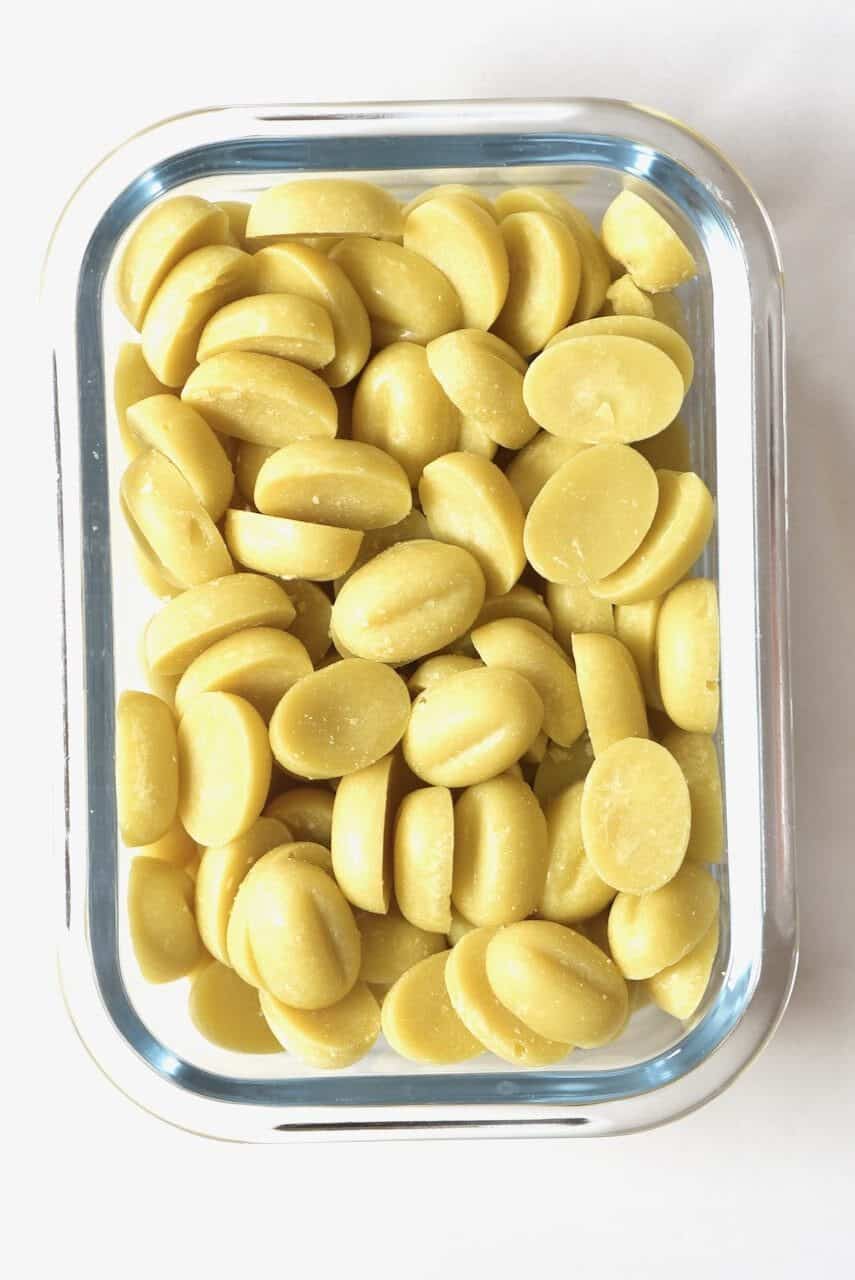
P.S. when items are named ‘cacao,’ rather than cocoa, these are more natural and less processed. So you may even be able to make raw white chocolate using cacao butter instead of cocoa butter.
How to make white chocolate
Making this homemade white chocolate is fairly easy. Best of all, it is just a few simple steps and three key white chocolate ingredients.
Check towards the bottom of the post for ways on how to flavor the white chocolate and several flavor variations.

- Cacao butter (or cocoa butter) Make sure to use food-grade cacao butter.
- Dry milk powder – I use homemade milk powder. For vegan white chocolate, you can use coconut milk powder or soy milk powder. I have also seen methods using cashew butter in place of dry powder, though this isn’t something that I’ve tried. DON’T use liquid ‘milk’ for this recipe or the chocolate will likely seize and/or won’t chill solid.
- Sweetener – use your favorite powdered sugar: coconut sugar, cane sugar, monk fruit powder, etc. If you only have granulated sugar, you can make your own powdered sugar. You can also use a sugar-free alternative such as powdered erythritol. AVOID liquid sweetener though, like maple, which can cause the chocolate to seize.
- (Optional) Vanilla – I often like to add vanilla to my bade white chocolate recipe. You can use vanilla straight from the pod, vanilla powder (or even vanilla extract – though there is a small risk of the chocolate seizing. It’s best to use an oil-based flavoring if possible.)
You’ll also need the equipment to use a double boiler method for melting the cacao butter and chocolate mold. This recipe is enough for 1 bar using the silicone mold photographed below. Feel free to adapt the mold to your liking – however, avoid hard (non-flexible) chocolate molds unless you plan to temper the chocolate.

Use a silicone spatula, too, or another non-wooden spoon (to avoid the porous material leeching water into the white chocolate and causing it to seize).
Topping Ideas
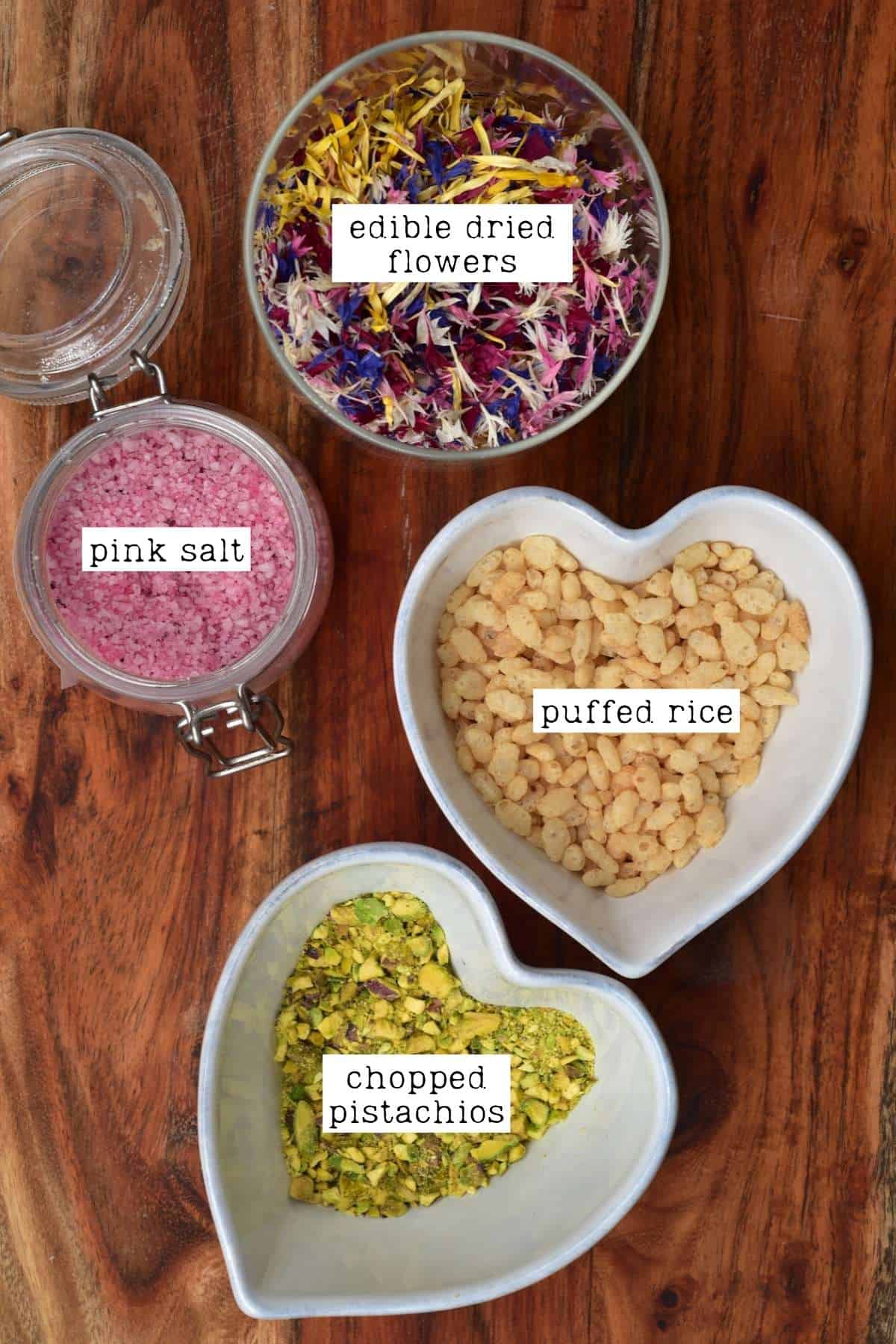
There are hundreds of ways to flavor and top homemade white chocolate. Here are just a few of my most recent experiments.
- Salt – I like using pink salt
- Puffed rice or puffed quinoa
- Chopped nuts – I love adding pistachios but you can add your favorite nut or combination of nuts
- Dried edible flowers
The Method
Step 1: Melt the cacao butter
If you have a large piece of cocoa butter, begin by chopping it down to smaller chunks. You can have uneven chunks but the smaller, more even pieces will melt faster and more evenly.
Set up a double boiler by placing a heatproof bowl over a pan of water. Make sure that the water isn’t touching the bottom of the bowl and set over medium-low heat. Bring to a gentle simmer – don’t boil as this increases the risk of scorching and water getting into your chocolate, which may cause it to seize.
Add the cacao/cocoa butter to the bowl, and it will melt without scorching or reaching temperatures that are too high. Stir or whisk* the butter often during this process to ensure even melting.
*It’s best to use silicone spatula or whisks for this, rather than wooden spoons. Wood may hold moisture and affect the chocolate.
Step 2: Add the remaining Ingredients
Once melted, add the powdered sugar to the bowl. It’s best to sift this into the bowl if you think it may have some lumps, as this can affect the final texture of the chocolate. Stir well to dissolve the sugar dissolves.
Then add the milk powder. Again, you can sift it into the bowl to avoid any lumps.

Turn off the heat before removing the bowl from the pan.
Step 3: Grind the chocolate
Next, to make extra smooth white chocolate and avoid grainy texture, I recommend pouring the mix into a food processor/blender and blending for 2-3 minutes. Now you are ready to move to the next step.
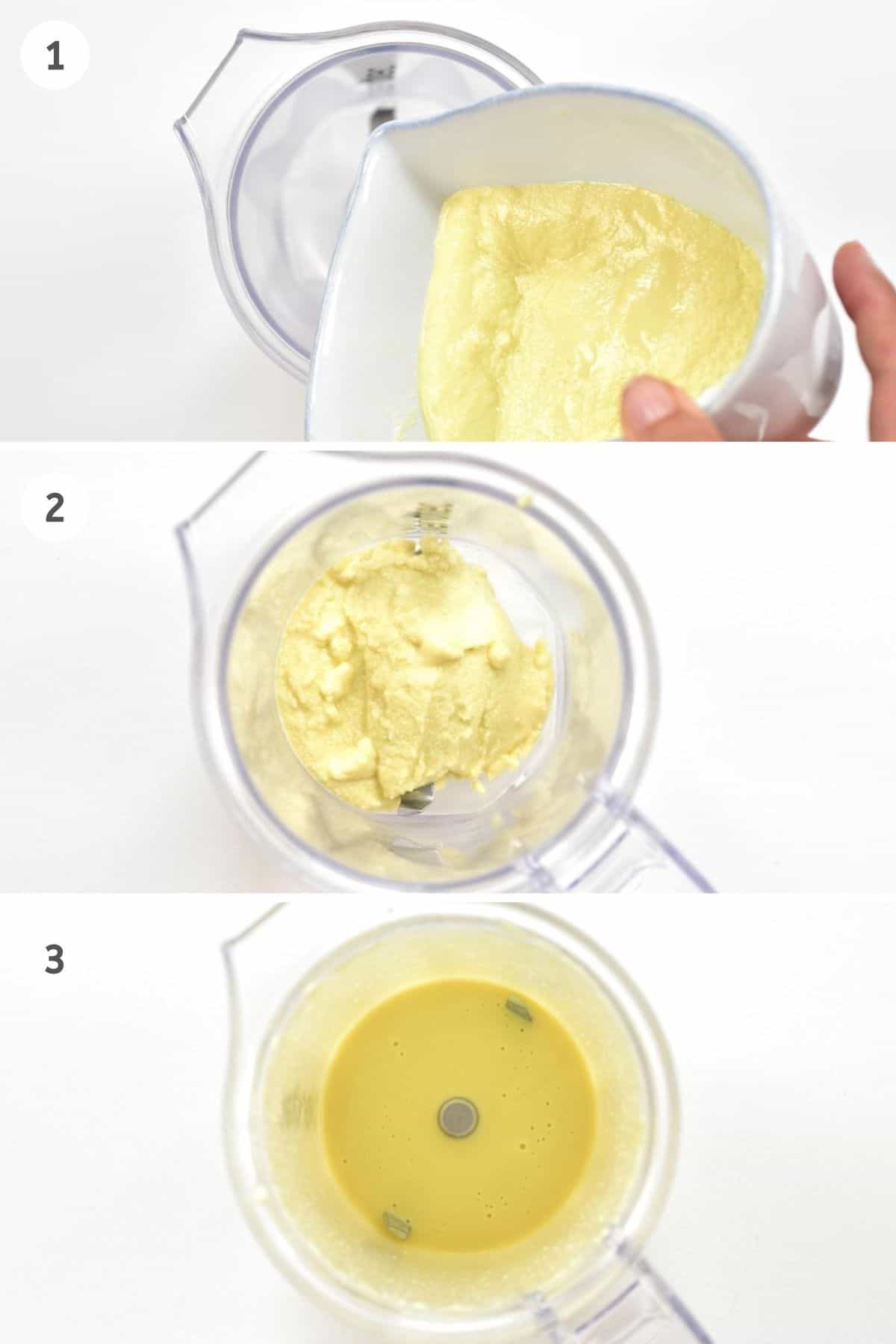
Alternatively, if you have a chocolate grinder (chocolate melanger), you can let it run for several hours (or overnight) to grind the chocolate. This will grind the particles within the chocolate into tiny tiny microparticles until they are no longer discernible by the human tongue – like commercial chocolate.


If you want to add any additional flavorings, then it’s usually best to do this once the heat is off. You can also sprinkle ‘toppings’ directly into your chocolate molds.

Step 4: Mold the white chocolate
Pour the white chocolate into your mold(s) of choice and place it in the freezer to set. This should only take 20-30 minutes, and then they can be transferred to the fridge (or kept in the freezer).
I prefer setting it in the fridge for about 2 hours.
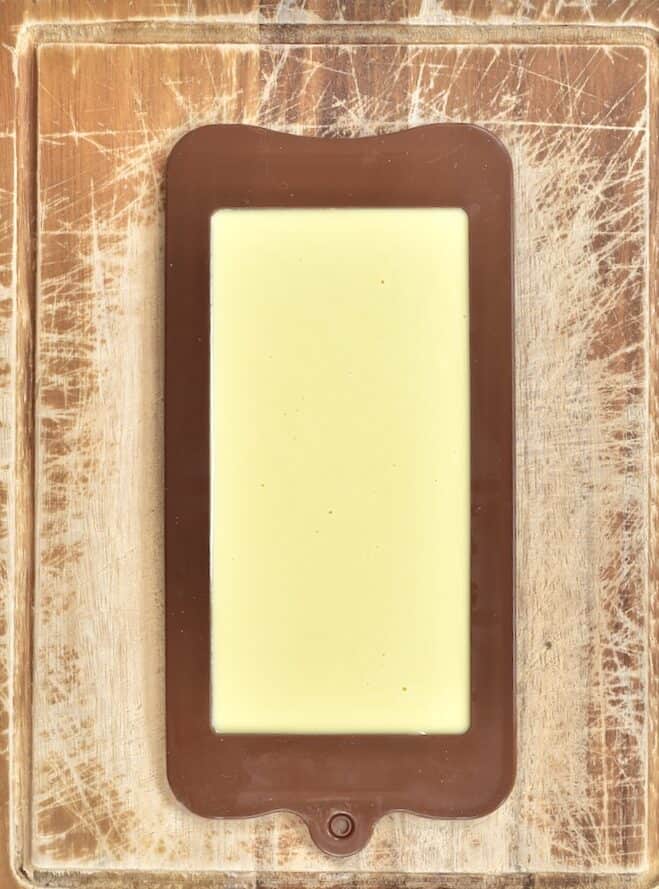
How To Store
Because this homemade white chocolate is untempered, I keep mine stored in the fridge. It will last for two weeks in the fridge. Alternatively, keep them stored in the freezer for 2-3 months (if they last that long!).
How to flavor white chocolate
Once you have the base white chocolate recipe sorted then you’re finally able to start experimenting. There are just a few rules when it comes to flavoring white chocolate, otherwise, you have tons of options!
First, avoid all water-based ingredients – this includes water-based coloring and flavorings. These can cause the chocolate to seize. This can be the case with alcohol-based flavorings too (like vanilla extract), though I’ve had some luck with the extract before.
I recommend using oil-based flavorings – also referred to as ‘chocolate flavoring’ or ‘candy flavoring’. Alternatively, you can also use powdered ingredients including spices (cinnamon, ginger, etc.) as well as freeze-dried fruit powder, etc.
As is the case with all chocolate, you can also mix in or top the homemade white chocolate with tons of different ingredients including crushed biscuits and sweets, freeze-dried fruits, coffee beans, etc.

White Chocolate Flavor Variations
Here are just a few flavor variations to get you started with your experimentation. Whether you want to make vegan white chocolate, sugar-free white chocolate, etc. There are ways to adapt this recipe to your liking.
- Raspberry rose: sprinkle freeze-dried raspberry into the mold, optionally with some edible rose petals, then flavor the white chocolate with rose and raspberry flavorings (optionally with some freeze-dried raspberry powder in the chocolate for a pink bar)
- Eton Mess: add pavlova, freeze-dried strawberry, and optionally some pink sprinkles or pink pearls to the bottom or top of the chocolate mold. Optionally swirl some strawberry-flavored chocolate into the plain white chocolate (more a marbled effect).
- Oreo Slab: add ground Oreo biscuits (filling not included) to the melted chocolate mixture and top with some crushed whole Oreos and, optionally, some chocolate balls/pearls.
- Peppermint: add a few drops of peppermint oil flavoring to the chocolate and top with some crushed peppermint candies.
- Orange raspberry: Add some finely diced candied orange slices (dried- not in liquid) to the white chocolate bar along with freeze-dried raspberry pieces.
You can also easily top the white chocolate bars with all sorts of crushed/ chopped candy bars and commercial candy/chocolate/biscuits, etc.

Further Notes & Variations
- Some cocoa butter is sold with cosmetic uses in mind and may not be food-safe. Be sure to buy food-safe cocoa butter for this recipe
- This white chocolate recipe sets very solid. However, as it is untempered chocolate, it is best stored in the fridge.
- If you don’t want to blend the chocolate mixture, then it’s VERY important to sift the dry powders into the melted cacao butter.
- To temper the white chocolate, use one of these chocolate tempering methods. Once tempered you can use the chocolate for truffles and bonbons and even store it at room temperature.
- Reduce the amount of milk powder used for a less ‘rich’ white chocolate.
- If, at any point, your chocolate seizes then slowly add a little additional cacao butter or vegetable shortening (1tsp at a time) and it should help bring it back together.
More chocolate tutorials
- How To Make Milk Chocolate
- How To Make Healthy Dark Chocolate
- Homemade Filled Chocolates (Vegan Chocolate Candy)
- How To Temper Chocolate (Multiple Methods)
- Simple Hot Cocoa Recipe (+ Hot Chocolate Bar Ideas)
- How to make chocolate – From bean to bar!
If you use this method for how to make white chocolate, let me know your thoughts and questions in the comments. I’d also really appreciate a recipe rating and would love to see your recreations – just tag @AlphaFoodie.

How To Make White Chocolate
Equipment
- Double boiler
- Stone Wet Grinder optional
Ingredients
- 1.4 ounces cacao butter
- 1.4 ounces milk powder (for vegan white chocolate use powdered coconut milk or soy milk)
- 0.7 ounces white powdered sugar
Instructions
- If you have a large piece of cocoa butter, chop it into smaller pieces. You can have it in uneven chunks, and I'll often do it this way, but the smaller, more even pieces will melt faster and more evenly.

- Set up a double boiler by placing a heat-proof bowl over a pan of water. Make sure that the water isn't touching the bottom of the bowl and set over medium-low heat. Bring to a gentle simmer – don't boil as this increases the risk of scorching and water getting into your chocolate which may cause it to seize.

- Add the cocoa butter to the bowl to melt without scorching or reaching temperatures that are too high. Stir or whisk* the cocoa butter often during this process to ensure even melting.

- Once melted, add the powdered sugar and stir well to dissolve it.

- Then add the milk powder and stir to incorporate.

- Transfer the melted whited chocolate to a blender/food processor and blend to make the mixture smooth.**Alternatively, if you have a chocolate grinder ( chocolate melanger), you can let it run for several hours to grind the chocolate. This will grind the particles within the chocolate into tiny tiny microparticles until they are no longer discernible by the human tongue – like commercial chocolate.

- Pour the mixture into the mould/s of your choice and leave in the fridge or freezer to set. You can then transfer the chocolate to an airtight container in the fridge (or keep it in the freezer).

Video
Notes
- Some cocoa butter is sold with cosmetic uses in mind and may not be food-safe. Be sure to buy food-safe cocoa butter for this recipe
- This white chocolate recipe sets very solid. However, as it is untempered chocolate, it is best stored within the fridge.
- If you don’t want to blend the chocolate mixture then it’s VERY important to sift the dry powders into the melted cacao butter.
- To temper the white chocolate, use one of these tempering chocolate methods. Once tempered you can use the chocolate for truffles and bonbons and even store it at room temperature.
- Reduce the amount of milk powder used for less “rich” white chocolate.
- If, at any point, your chocolate seizes then slowly add a little additional cacao butter or vegetable shortening (1tsp at a time) and it should help bring it back together.
Nutrition
Nutrition information is automatically calculated, so should only be used as an approximation.


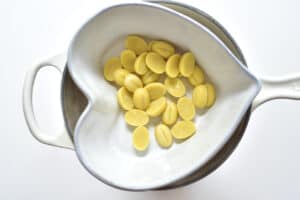














So I’ve just started getting into making my own sugar-free chocolate using an erythritol stevia blend and came across your recipes.and have now made one batch each of dark, milk and white using cacao butter and powder. All seemed to have tempered fine using the “seeding” method without a seed and with a cold water bath to help cooling (of course being very careful with the water).
The dark was 70% cacao (50/50 ratio), it was a bit gritty but not unpleasant. It tasted nice and rich but sweeter than I thought, turns out my sweetner (Natvia stevia blend) is sweeter than sugar with a ratio of around 1:1.51 putting it more in line with 60% level sweetness. I’ve since adjusted the sweetner amount for the 3 recipes and increased the butter to compensate.
The milk chocolate came out really good and smoother than the dark likely thanks in part to the additional butter. Did some pieces with turkish delight jelly (also had a few darks with turkish delight too) and others with desiccated coconut.
The white came out good taste wise, done a number with strawberry flavour with a bit of the chocolate mixed with red food colouring which thankfully didn’t seize (water-based, mixed 3 drops with some melted cacao butter I set aside then mixed in few spoons of chocolate). Unfortunately the texture was considerably more gritty than the dark, though still not unpleasant (for me anyway), despite the extra butter and I even ended up adding another 25-30g on top of that. In retrospect I for some reason didn’t even think to sift the powder in and didn’t use a blender, though I wouldn’t have fancied the idea of moving it between a blender and potentially wasting a bit. How do you think a hand blender would go making it a bit smoother? I’ve also looked into using lecithin, likely sunflower, which should help with smoothness and flowability.
Sorry for the long-winded comment and referring to the other two recipes here, didn’t want to separate the comments. And thanks for these great recipes, never thought making my own chocolate would be so easy.
Hi Harley,
Thank you so much for your detailed feedback. Your combinations sound delicious. I’m so happy you’ve tried all the recipes!
Regarding the white chocolate – a hand-held blender could indeed help smooth it a bit. You can also sieve the dry ingredients before mixing them into the melted cacao butter. Let me know how it goes if you give it another try 🙂
i love it so much you don’t know i love it
Thank you for your comment 🙂
Question: It appears the basic recipe is 2 parts Cocoa Butter, 2 parts Milk Powder and 1 part Powdered Sugar. As it can be challenging to measure chunks or wafers of cocoa butter in fluid oz, will measuring all the ingredients with a scale produce the same results ?
Hi Doug,
Thank you for your comment, I’ve changed the measurements on my blog to grams. I hope this makes it easier for you.
I’ve a question about it
Question: Can we use any substitute of cocoa butter, I mean can we replace cocoa butter with any other like butter, ghee Or oil something like that..??
Because I’ve tried with butter and ghee simultaneously and it’s result is ridiculous, it’s formed like a dough
I don’t how to react on it because it’s totally different how they show in YT videos
Hi Priyanka,
Unfortunately it won’t work for this white chocolate recipe, but you can replace the cacao butter for coconut oil in this milk chocolate recipe:
https://www.alphafoodie.com/how-to-make-homemade-milk-chocolate/#recipe
Hi Samira,
thank you for such a wonderful recipe! I am just wondering – if I want to temper my chocolate, can I do it right when I have everything melted before I pour it to the mold or is it neccessary to actually make untemepred chocolate first (let it cool down) and after that start with tempering?
Thanks for any kind of advice!
David
Hi David,
You can start the tempering when everything is melted. Once tempered, you can pour in your mold. For more tips, check my post for tempering:
https://www.alphafoodie.com/how-to-temper-chocolate/
How would you temper this recipe since there is not any already tempered chocolate to do the “seeded” method? Do I need to pour it out on a marble slab and work it? I hope not.. those are expensive
Hi Jamie,
I have a blog about tempering chocolate if you would like to read through it:
https://www.alphafoodie.com/how-to-temper-chocolate/
Hi
What is the quantity of each ingredient you used ? It is not specified!”
Thank you
Hi Baria,
The quantities are all listed in the recipe card at the bottom of the post. On top, you can click on “Jump to Recipe” and that will take you straight to the ingredient quantities. You can then also select US Customary or Metric.
Can you make this recipe without adding any sugar? I want to use this as a base for a coffee ganache that has NO sweetener in it at all and I don’t want to use unsweetened dark chocolate because I don’t want that flavor in my dessert. It will be part of a bigger dessert where the other elements are very sweet so this layer would act as a balance to the rest of the sweet. Does the powdered sugar do anything to help set the chocolate or maybe if I just add cornstarch it will do the same thing as the powdered sugar without the sugar? How much cornstarch would that be then? Also if I don’t add powdered sugar would I still have to blend it to get a smooth consistency?
Hi Michelle,
You don’t have to use a sweetener. You will still have to blend it to get a smooth texture, the powdered milk will also give it a grainy texture if you don’t grind/blend it.
I followed this recipe exactly with Anthony’s cocoa butter wafers, Anthony’s coconut milk powder and Wholesome powdered sugar – and an Oster blender at the end. I used it both as a drizzle for another recipe and put the rest into a silicone mold. It turned out perfectly. Everyone loved it. It was better that store white chocolate which is often cloying sweet.
Thank you so much for your feedback, Harmony! I’m so happy to hear! I hope you give some of my other recipes a try! 🙂
Hi there ,
Thanks for sharing this recipe with everybody 🙂
I have one question : the final result of bars is 100 % creamy , or when you eat it can feel something grainy in the mouth ?
Thanks
Hello,
For a smooth result, you have to grind the white chocolate for some time before you pour it into the molds. Stay tuned, there’s an update coming with lots of tips for how to achieve super-smooth chocolate and a new post about tempering as well.
Hey!! Did you add the super smooth tips or is it the blender tip? looking forward to try the recipe
Hi Vik,
I usually just blend it in my blender – that helps the chocolate become smoother. I do have a chocolate grinder (chocolate melanger), which makes it super smooth but it needs to run for hours so I usually prefer my blender. I hope this helps.